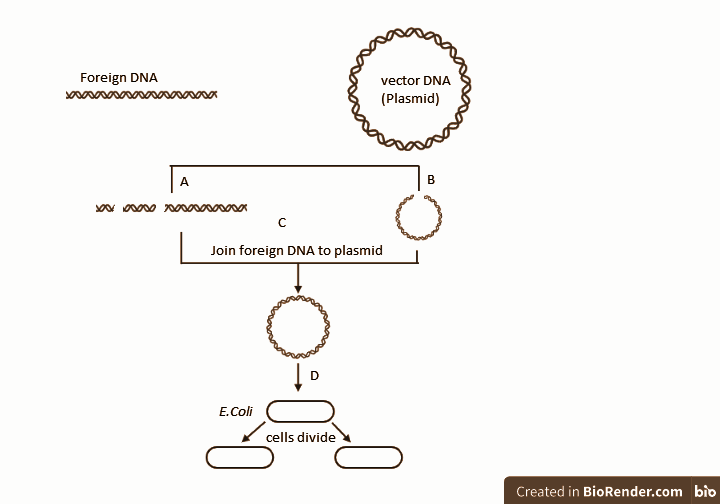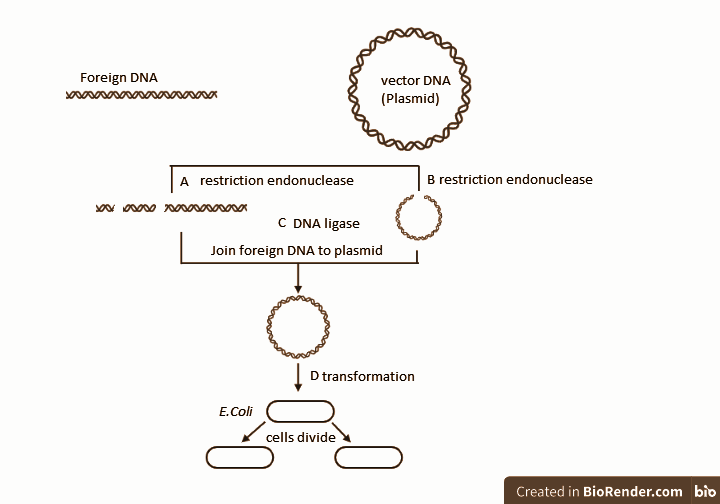
The flow chart given below represents the process of recombinant DNA technology. Identify A, B, C, and D.

A. A - Restriction endonuclease, B - Restriction exonuclease, C- DNA ligase, D - Transformation.
B. A - Restriction endonuclease, B - Restriction endonuclease, C- DNA ligase, D - Transformation.
C. A - Restriction endonuclease, B - Restriction endonuclease, C- Hydrolase, D - Transformation.
D. A - Restriction endonuclease, B - Restriction endonuclease, C- Hydrolase, D - Transduction.

Answer
470.7k+ views
Hint: The term DNA stands for deoxyribonucleic acid. DNA is considered as the genetic material of an organism. Joining two different DNA molecules of two different species using different enzymes is called recombinant DNA technology. This method is used to alter the genetic material of an organism.
Complete answer: The phenotype of a host organism can be altered through a genetically altered vector in a process called recombinant DNA technology. The cloning vector is inserted and integrated into the genome of the organism. In simple terms, recombinant DNA technology means the insertion of foreign DNA into the genome of host organisms which contains our gene of interest.
The various tools included in recombinant DNA technology are enzymes, vectors and the host organism. The gene that is a section of DNA which is to be inserted needs to be isolated first. The DNA of host organisms is cleaved at recognition sites using restriction enzymes called endonuclease. Therefore, A and B are restriction endonucleases. The desired DNA fragment is isolated. The gene which is to be inserted is amplified. The desired gene is integrated into the vector using DNA ligase and recombinant DNA is formed. Therefore, C is a DNA ligase. This recombinant DNA or rDNA is inserted into the host and the process is called transformation. So, D is transformation. The host cells are cultured on a suitable medium on a large scale and the desired product is extracted.
So, option B is the correct answer.

Note: Restriction site is also called a restriction recognition site. Recombinant DNA technology is also called genetic engineering. The discovery of recombinant DNA technology emerged along with the discovery of restriction enzymes in the year 1968 by Swiss microbiologist Werner Arber.
Complete answer: The phenotype of a host organism can be altered through a genetically altered vector in a process called recombinant DNA technology. The cloning vector is inserted and integrated into the genome of the organism. In simple terms, recombinant DNA technology means the insertion of foreign DNA into the genome of host organisms which contains our gene of interest.
The various tools included in recombinant DNA technology are enzymes, vectors and the host organism. The gene that is a section of DNA which is to be inserted needs to be isolated first. The DNA of host organisms is cleaved at recognition sites using restriction enzymes called endonuclease. Therefore, A and B are restriction endonucleases. The desired DNA fragment is isolated. The gene which is to be inserted is amplified. The desired gene is integrated into the vector using DNA ligase and recombinant DNA is formed. Therefore, C is a DNA ligase. This recombinant DNA or rDNA is inserted into the host and the process is called transformation. So, D is transformation. The host cells are cultured on a suitable medium on a large scale and the desired product is extracted.
So, option B is the correct answer.

Note: Restriction site is also called a restriction recognition site. Recombinant DNA technology is also called genetic engineering. The discovery of recombinant DNA technology emerged along with the discovery of restriction enzymes in the year 1968 by Swiss microbiologist Werner Arber.
Recently Updated Pages
Master Class 12 Social Science: Engaging Questions & Answers for Success

Class 12 Question and Answer - Your Ultimate Solutions Guide

Class 10 Question and Answer - Your Ultimate Solutions Guide

Master Class 10 Science: Engaging Questions & Answers for Success

Master Class 10 Maths: Engaging Questions & Answers for Success

Master Class 9 General Knowledge: Engaging Questions & Answers for Success

Trending doubts
The gas that burns in oxygen with a green flame is class 12 chemistry CBSE

The probability that a leap year will have only 52 class 12 maths CBSE

Describe the poetic devices used in the poem Aunt Jennifers class 12 english CBSE

And such too is the grandeur of the dooms We have imagined class 12 english CBSE

What does the god that failed refer to class 12 english CBSE

Which country did Danny Casey play for class 12 english CBSE




